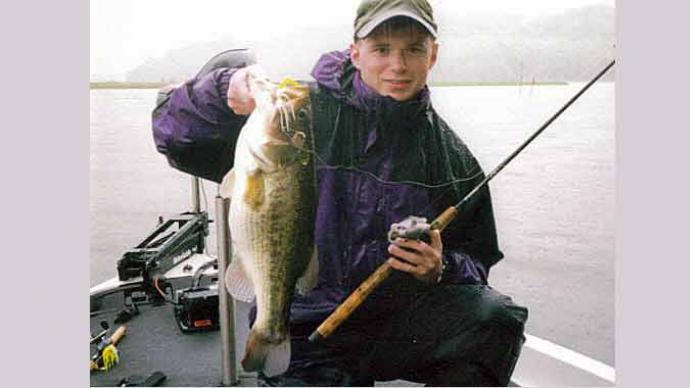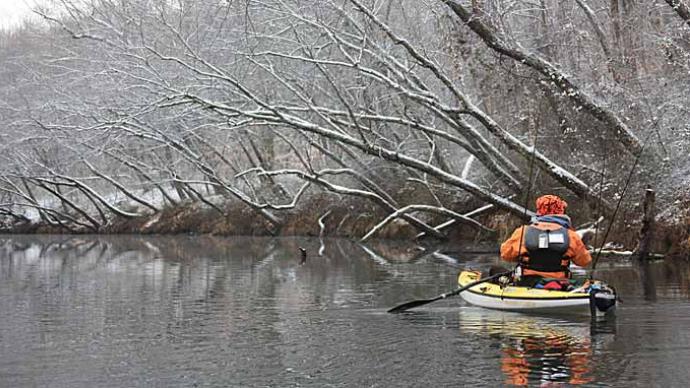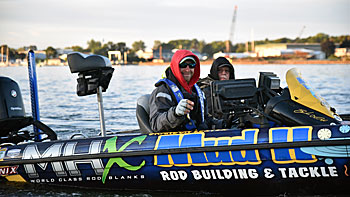
Brandon Lester has felt the effects of cold-water fishing firsthand. During his club tournament days, he was practicing for a wintertime tournament, and the water temperature was in the low 40s. He was fishing parallel to bluff walls, a typical wintertime pattern for the waters near his Fayetteville, Tenn., home. When he hooked a bass, his rod popped out of his hands, wet and numbed by the cold. Instinctively, he lunged for the rod, slowly sinking out of sight, only to lose his balance and tumble into the lake.
After the initial shock, he knew he had to get out of the water after the initial shock. “It’s tough to get back in [a bass] boat,” Lester said. So he swam to a nearby dock and pulled himself from the water. Luckily the owners of a nearby home were there, and they allowed him to come in, dry off and warm up. Today, the Phoenix Boat he runs on the Bassmaster Elite Series has a boarding ladder, making getting back into it more manageable if he ever falls out again.
That’s just one change Lester has made to make him more efficient when fishing cold water. He also adjusts his locations and lures. Understanding why those changes are needed is essential to put more bass in your boat during the year's coldest months.
Winter’s effects
Bass are cold-blooded creatures, and their metabolism and activity are directly related to the water temperature in which they swim. As water temperature rises, for example, so does the bass activity. Take largemouth, for example, which prefer water temperatures between 65 and 85 degrees. Their activity slows when the temperature is outside that range, especially when it falls to the cold side.
“The biggest thing is they get lethargic,” Lester said, who fished his sophomore Bassmaster Elite Series season in 2015, finishing 37th and punching a ticket to the 2016 Bassmaster Classic on Oklahoma’s Grand Lake. But how much of an effect it has depends on where the country bass are, he said, because the environment conditions fish.
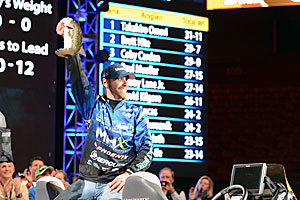
In Northern states, water temperatures barely top 80 degrees during summer. So water in the high 30s doesn’t shock bass there as much as it does their Southern cousins, who spend the summer swimming a thin line between surviving and poaching in water temperatures that hover near triple digits for extended periods.“You have to know how your fish react,” he said.
Wintertime bass fishing starts when water temperatures fall into the lower 40s and upper 30s. In the South, that means slowly fishing with smaller lures and a light line. In the North, you can fish slightly larger lures a little faster. And in both regions, even a slight bump in water temperature can activate bass. “During the summer, I don’t even look at my water temperature [gauge],” Lester said. “In winter, I study it. One or two degrees can make a big difference.”
You don’t have to look further than the 2015 Bassmaster Classic to see that proven. It was Lester’s first trip to the world’s most prominent bass tournament, and it lived up to its billing as a test of the best. On the first morning, the air temperature was 9 degrees, the coldest Anderson, S.C., has been on that date in more than 60 years. It was so frigid that municipal trucks spread salt and sand across the boat launch and emergency officials delayed blast off by an hour. Like many other competitors, it was the coldest weather Lester had fished.
Many were fishing deep docks, brush piles, and points in the lower lake, where water temperatures were in the mid-to-high 30s that day. Some more protected coves and pockets were covered in skim ice until lunchtime. Lester went in the other direction. He ran up the Seneca River with the Tugaloo and Hartwell’s two largest tributaries. There he found water in the mid-50s, thanks to a power-plant discharge, and enough willing bass to help propel him to a 19th place finish.
Wintertime spots
Wintertime is an in-between season for bass. They’ve left the shallows, where they spent fall corralling and feasting on baitfish, and they are waiting for spring and its longer and warmer days to arrive before returning there to spawn. The spots they choose to spend winter are defined by depth and cover.
Lester seeks outbreaks that fall into the lake at 45 or more degrees. It’s essential that these near-vertical drops are near a creek or river channel, too, he said. The sharp drops can be along a bank. They can form the end of a point or a channel ledge far from shore. The exact depths will depend on the lake’s topography. There is one type of cover he prefers on these breaks. “I’m looking for rock,” he said. Rock absorbs solar energy and discharges it as heat into the surrounding water, which attracts bass-like steel filings to a magnet. This combination of cover and structure will yield the highest percentage of spots for catching wintertime bass. He said to concentrate on finding and fishing until you find the areas the bass are using.
Lester starts his search for rock-infused drops in the main lake. He will explore creeks but will only go halfway back. That’s usually where they run out of water deep enough to hold wintertime bass. But there is one exception. He’ll explore the back if he knows warmer water enters the lake.
Warm-water inflows aren’t the only situations that can make shallow fishing good in winter. “People think [wintertime] fish are deep,” Lester said. “There are still fish up shallow. They are not always deep.” After a few consecutive warm days, the bass will move as shallow as a couple of feet. They won’t travel distances to take advantage of it, so concentrate your exploration on flats and pockets that are near the drops where you have been catching them.
What to throw
In winter, the best lures allow you to fish fast and slowly. While that may seem like an oxymoron at first glance, it’s not. You need a lure that can comb water quickly to isolate the best spots yet has enough action, when slowly retrieved, to entice strikes from lethargic bass. One of the best is a crankbait. In winter, Lester stores the big, wide wobbling ones he throws from late spring through summer and chooses sleek and slender ones with a tight wobble. One of the most popular is a Rapala Shad Rap. He grinds them along rock bottoms. Bites are often subtle. Your lure will feel heavy or stop vibrating. Set the hook if either occurs.
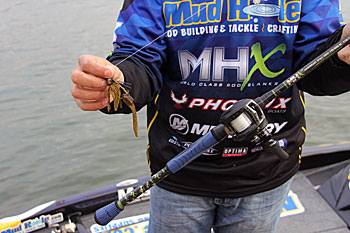
Beyond a tight-wobbling crankbait, a handful of lures are perfect for wintertime bass fishing. Jerkbaits are one. They will produce in the coldest water with longer pauses when they should sink slightly. Spinnerbaits and lipless crankbaits are other choices, and you’ll want to slow roll or yo-yo them.
Once he has found a few spots that hold a concentration of bass, Lester switches lures to work them over. Jigs — both bucktail and skirted — are good choices. So are jigging spoons, which can be fished vertically, if you can hold your boat above the bass without spooking them, or cast and retrieved with short hops, like how larger structure spoons are fished in early summer. Blade baits, such as a Silver Buddy, and tail spinners, such as Mann’s Little George, produce when fished similarly.
Lure choices aren’t limited to hard baits. Historically, soft-plastic lures have been reserved for warmer water, but compact ones have a place in wintertime fishing. A simple grub threaded on a lead-head jig is probably the best. Sickle-tail grubs produce, but ones with flat, spade-like tails can sometimes be better. Traditionally rigged tubes and small worms fished on a drop-shot rig will have their days, too.
You’ll need lighter line and a lighter action, and power rod to handle these lures. A fluorocarbon line is the best choice for moving baits. It sinks, which keeps your lure down and in the strike zone. Use braid for slower-moving lures. It’s more sensitive than fluorocarbon, which will help you feel the softest bites. Braid works with spoons and blade baits, too. Even the slightest movement of your rod tip will be reflected in the lure because the line has no stretch.
Gear adjustments
Keeping your head in the game is one of the most important aspects of finding wintertime bass. You won’t catch many bass in the boat ramp parking lot, sitting in your running truck trying to keep warm. The same goes for toughing it out on the water, shivering, and thinking about being in your warm truck.
Dress for the conditions by wearing insulating layers, such as fleece, covered with a rain suit, which will keep the wind out and trap warm air inside. Tuck hand warmers in your pockets for your fingers, but also put a few between layers. They will help keep your core warm and your extremities warm. Bring several pairs of gloves, including fingerless ones for fishing and full ones for running. That also will allow you to swap a wet pair for a dry one.
On the coldest days, keeping ice from forming in your rod’s line guides and reel can be difficult because of the water the line brings in during your retrieves. “I’ve heard of some old tricks of spraying some things on your equipment [to keep ice from forming],” Lester said. But he hasn’t found one that works better than dipping your rod in the water and then shaking off the water. He does advise avoiding rods with micro guides. Their small openings freeze close with only a tiny amount of water.
Your boat needs tender loving care during cold weather, too. Lester lets his outboard warm-up for about five minutes before racing down the lake. Work the steering back and forth and ensure the compartment lids and trolling motor aren’t frozen closed. Also, if you remove the drain plug between trips, check the opening for ice, which may have to be removed before the plug can be inserted.
Lester knows from personal experience that the most critical part of wintertime bass fishing is wearing a personal flotation device. Taking it off is usually the first thing anglers do when stopping to fish. But leaving it on can be a matter of survival during the winter. Some states, such as New York, require you to wear one throughout the winter. Try an inflatable vest if you feel a traditional foam vest is too bulky. They are comfortable and do not restrict your movements. Just make sure it will automatically inflate.


